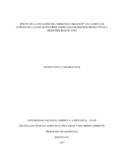Mostrar el registro sencillo del ítem
Efecto de la inclusión del simbiótico Organew® en la dieta de conejos en la fase de engorde sobre los parámetros productivos y digestibilidad In vivo.
| dc.contributor.advisor | Barreto de Escovar, Leonor | |
| dc.coverage.spatial | cead_-_josé_acevedo_y_gómez | spa |
| dc.creator | Camargo Díaz, Lennis Paola | |
| dc.date.accessioned | 2017-11-01T00:52:11Z | |
| dc.date.available | 2017-11-01T00:52:11Z | |
| dc.date.created | 2017-06-15 | |
| dc.identifier.uri | https://repository.unad.edu.co/handle/10596/13542 | |
| dc.description.abstract | Se realizó un ensayo para investigar los efectos de la suplementación del simbiótico comercial Organew® (Ow) en conejos durante el periodo de engorde, con el fin de evaluar la digestibilidad In vivo de nutrientes (Coeficiente de Digestibilidad de Materia Seca (CDMS), Coeficiente de Digestibilidad de Materia Orgánica (CDMO), Coeficiente de Digestibilidad de Proteína Bruta (CDPB), Coeficiente de Digestibilidad de Fibra detergente neutro (CDFDN), Coeficiente de digestibilidad de Extracto etéreo (CDEE) y el desempeño productivo (Peso final, Consumo medio diario, Ganancia de peso diario, conversión alimenticia y mortalidad). Fueron utilizados 48 conejos de raza Nueva Zelanda blanco con edad promedio de 35 a 40 días, con peso promedio de 786,25g ±93,82. El diseño fue completamente al azar con 4 tratamientos y 3 repeticiones. Los tratamientos fueron los siguientes: T1 =Dieta base (sin simbiótico), T2= Dieta base + 1g Ow/kg, T3=Dieta base + 2g Ow/kg, T4 =Dieta base + 4g Ow/kg. El periodo experimental tuvo una duración de 42 días, siendo 27 días de adaptación a las dietas y 4 días de colecta de las heces. Los datos obtenidos fueron sometidos a análisis de varianza y, las medias comparadas usando el test de Tukey, ambos a un nivel de 5% de significancia, utilizando el Sistema estadístico R Core Team®. Fueron encontradas diferencias estadísticas significativas (P<0.05) en los coeficientes de digestibilidad de MS, MO, PB, y EE, donde el T1 obtuvo los valores más altos para los coeficientes de digestibilidad de MS y MO, los conejos del tratamiento T2 (1g Ow/kg) tuvieron el valor más alto (P<0.05) para el peso final. Se concluye que la adición del simbiótico comercial Organew® tuvo efecto sobre el peso final de los conejos en fase de engorde, en cuanto a los coeficientes de digestibilidad estos fueron afectados negativamente por el alto nivel de fibra de la dieta base. | spa |
| dc.format | spa | |
| dc.format.mimetype | application/pdf | spa |
| dc.language.iso | spa | spa |
| dc.publisher | Universidad Nacional Abierta y a Distancia UNAD | spa |
| dc.title | Efecto de la inclusión del simbiótico Organew® en la dieta de conejos en la fase de engorde sobre los parámetros productivos y digestibilidad In vivo. | spa |
| dc.type | Proyecto de investigación | spa |
| dc.subject.keywords | Alimentación – Nutrientes | spa |
| dc.subject.keywords | Conejos de Engorde – Dietas | spa |
| dc.subject.keywords | Digestibilidad in vivo | spa |
| dc.subject.keywords | Evaluación - Parámetros productivos | spa |
| dc.description.abstractenglish | A feeding trial was made to investigate the effects of supplementation of the commercial Organew® (Ow) synbiotic in rabbits during the fattening period with the purpose of evaluating the in vivo digestibility of nutrients (Coefficient of digestibility of dry matter (CDMS), coefficient of digestibility of organic matter (CDMO), coefficient of digestibility of crude protein (CDPB), coefficient of digestibility of neutral detergent fiber (CDFDN), coefficient of digestibility of ethereal extract (CDEE)) and performance (final weight, daily feed intake, average daily gain, feed conversion ratio and mortality). It was used forty-eight New Zealand white rabbits (35 to 40 days old; 786,25g±93,82 average body weight). The experimental design was completely random with 4 four treatments and 3 repetitions. The treatments used were the following: T1 =basal diet (without symbiotic), T2= basal diet + 1g Ow/kg, T3=basal diet +2g Ow/kg, T4 =basal diet+ 4g Ow/kg. The experimental period had duration of 42 days, with 27 days of adaptation to diets and 4 days of collection of feces. The obtained data were submitted to analysis of variance and subsequently the averages compared by the Tukey test, both at 5 % significance level, using the statistical system R Core Team®. Significant differences were found (P<0,05) in the coefficients of digestibility of MS, MO, PB, and EE, where the T1 obtained the highest values for the digestibility coefficients of MS and MO, the rabbits of the T2 treatment (1g Ow /kg) had the highest value (P <0.05) for the final weight. It was concluded that the addition of the commercial synbiotic Organew® had an effect on the final weight of the rabbits in the fattening period, as for the digestibility coefficients these were negatively affected by the high fiber level of the base diet. | spa |
| dc.subject.category | Zootecnia | spa |
| dc.rights.accesRights | info:eu-repo/semantics/openAccess | spa |
| dc.rights.acceso | Abierto (Texto Completo) | spa |
Ficheros en el ítem
Este ítem aparece en la(s) siguiente(s) colección(ones)
-
Zootecnia [278]















